

BURIED SECRETS -
is natural gas drilling endangering US water supplies
by Abrahm Lustgarten
Pro Publica
November 13, 2008
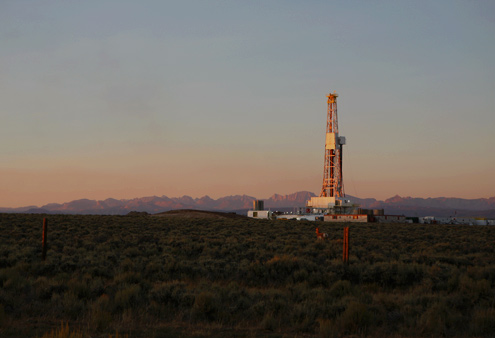 A drill rig near the town of Pinedale, Wyo. (Credit: Abrahm Lustgarten/ProPublica) |
In July, a hydrologist dropped a plastic sampling pipe 300 feet down a water well in rural Sublette County, Wyo., and pulled up a load of brown oily water with a foul smell. Tests showed it contained benzene, a chemical believed to cause aplastic anemia and leukemia, in a concentration 1,500 times the level safe for people.
The results sent shockwaves through the energy industry and state and federal regulatory agencies.
Sublette County is the home of one of the nation's largest natural gas fields, and many of its 6,000 wells have undergone a process pioneered by Halliburton called hydraulic fracturing, which shoots vast amounts of water, sand and chemicals several miles underground to break apart rock and release the gas. The process has been considered safe since a 2004 study (PDF) by the Environmental Protection Agency found that it posed no risk to drinking water. After that study, Congress even exempted hydraulic fracturing from the Safe Drinking Water Act. Today fracturing is used in nine out of 10 natural gas wells in the United States.
Over the last few years, however, a series of contamination incidents have raised questions about that EPA study and ignited a debate over whether the chemicals used in hydraulic fracturing may threaten the nation's increasingly precious drinking water supply.
An investigation by ProPublica, which visited Sublette County and six other contamination sites, found that water contamination in drilling areas around the country is far more prevalent than the EPA asserts. Our investigation also found that the 2004 EPA study was not as conclusive as it claimed to be. A close review shows that the body of the study contains damaging information that wasn't mentioned in the conclusion. In fact, the study foreshadowed many of the problems now being reported across the country.
The contamination in Sublette County is significant because it is the first to be documented by a federal agency, the U.S. Bureau of Land Management. But more than 1,000 other cases of contamination have been documented by courts and state and local governments in Colorado, New Mexico, Alabama, Ohio and Pennsylvania. In one case, a house exploded after hydraulic fracturing created underground passageways and methane seeped into the residential water supply. In other cases, the contamination occurred not from actual drilling below ground, but on the surface, where accidental spills and leaky tanks, trucks and waste pits allowed benzene and other chemicals to leach into streams, springs and water wells
It is difficult to pinpoint the exact cause of each contamination, or measure its spread across the environment accurately, because the precise nature and concentrations of the chemicals used by industry are considered trade secrets. Not even the EPA knows exactly what's in the drilling fluids. And that, EPA scientists say, makes it impossible to vouch for the safety of the drilling process or precisely track its effects.
"I am looking more and more at water quality issues…because of a growing concern," said Joyel Dhieux, a drilling field inspector who handles environmental review at the EPA’s regional offices in Denver. “But if you don't know what's in it I don't think it’s possible."
Of the 300-odd compounds that private researchers and the Bureau of Land Management suspect are being used, 65 are listed as hazardous by the federal government. Many of the rest are unstudied and unregulated, leaving a gaping hole in the nation's scientific understanding of how widespread drilling might affect water resources.
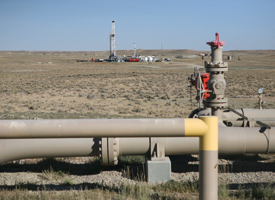 Abrahm Lustgarten/ProPublica |
"Halliburton's proprietary fluids are the result of years of extensive research, development testing," said Diana Gabriel, a company spokeswoman, in an e-mail response. "We have gone to great lengths to ensure that we are able to protect the fruits of the company's research…. We could lose our competitive advantage."
"It is like Coke protecting its syrup formula for many of these service companies," said Scott Rotruck, vice president of corporate development at Chesapeake Energy, the nation’s largest gas driller, which has been asked by New York State regulators to disclose the chemicals it uses.
Thanks in large part to hydraulic fracturing, natural gas drilling has vastly expanded across the United States. In 2007, there were 449,000 gas wells in 32 states, thirty percent more than in 2000. By 2012 the nation could be drilling 32,000 new wells a year, including some in the watershed that provides drinking water to New York City and Philadelphia, some five percent of the nation's population.
The rush to drill comes in part because newly identified gas reserves offer the nation an opportunity to wean itself from oil.
Natural gas, as T. Boone Pickens said recently, is "cleaner, cheaper… abundant, and ours." Burning gas, used primarily to heat homes and make electricity, emits 23 percent less carbon dioxide than burning oil. Gas is the country's second-largest domestic energy resource, after coal.
The debate over water arises at a critical time. In his last days in office President George W. Bush has pushed through lease sales and permits for new drilling on thousands of acres of federal land. President-elect Barak Obama has identified the leasing rush as one of his first pressing matters and is already examining whether to try to reverse Bush's expansion of drilling in Utah.
State regulators and environmentalists have also begun pressing the gas industry to disclose the chemicals they use and urging Congress to revisit the environmental exemptions hydraulic fracturing currently enjoys.
But in the meantime, the drilling continues.
In September, the Bureau of Land Management approved plans for 4,400 new wells in Sublette County, despite the unresolved water issues. Tests there showed contamination in 88 of the 220 wells examined, and the plume stretched over 28 miles. When researchers returned to take more samples, they couldn’t even open the water wells; monitors showed they contained so much flammable gas that they were likely to explode.
'Big Wyoming'
News that water in Sublette County was contaminated was especially shocking because the area is so rural that until a few years ago cattle were still run down Main Street in Pinedale, the nearest town to the gas field. The county is roughly the size of the state of Connecticut but has fewer people than many New York City blocks. With so little industry, there was little besides drilling that people could blame for the contamination.
"When you just look at the data…the aerial extent of the benzene contamination, you just say...This is huge,” says Oberley, who is charged with water study in the area. “You’ve got benzene in a usable aquifer and nobody is able to verbalize well, using factual information, how the benzene got there.”
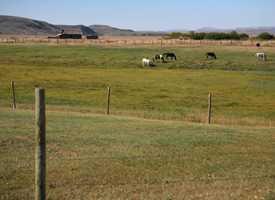 Sublette County, Wyo. (Credit: Abrahm Lustgarten/ProPublica) |
"We need the gas now more than ever," says Fred Sanchez, whose water well is among those with high levels of fluoride. But gazing off his deck at the prized trout waters of the New Fork River, he wonders whether drilling has gone too far. "You just can't helter skelter go drilling just because you have the right to do it. It's not morally right to do it. There should be some checks and balances."
Further east, in the town of Clark, the Wyoming Department of Environmental Quality found benzene in a residential well after an underground well casing cracked. In Pavilion, another small town, a series of drinking water wells began running with dark, smelly water, a problem a state official speculated might be linked to drilling nearby.
"There is no direct evidence that the gas drilling has impacted it," says Mark Thiesse, a groundwater supervisor for the Wyoming DEQ. "But it sure makes you wonder. It just seems pretty circumstantial that it’s happening."
On federal land, which is where most of the Sublette County wells are located, the BLM governs leasing and permitting for gas development, with secondary oversight from the state and only advisory input from the EPA. When the contaminated water results were first reported, both the BLM and the state downplayed their significance.
The EPA’s regional office in Denver sharply disagreed. But because it has only an advisory role in the federal review process, and hydraulic fracturing is exempted from the Safe Drinking Water Act, there was little the EPA could do. It rebuked the BLM in a strongly worded letter and gave the development plans in Sublette County a rare "unsatisfactory" rating. It also recommended that the project be stopped until further scientific study could be done.
The BLM, backed by a powerful business lobby, ignored that recommendation. Why do a study if you can’t prove something is wrong, industry argued.
Drilling operators said the benzene came from leaky equipment on the trucks that haul water and waste to and from the drill sites -- and in one or two cases, EPA scientists say that was likely. One theory put forth by the BLM blamed the benzene contamination on malicious environmentalists "hostile to gas production," an accusation the agency later said it had no evidence of.
Thiesse, the DEQ supervisor, recounted a meeting where the debate dwindled down to semantics: "I called it contamination, and somebody said is it really contamination? What if it's naturally occurring?"
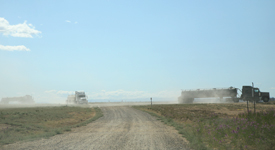
Leaky equipment on trucks was one reason put forth by drilling operators for benzene contamination. Above, trucks are seen hauling water and waste to and from drilling sites. (Credit: Abrahm Lustgarten/ProPublica) |
"You have intervening rock in between the area that you are fracturing and the areas that provide water supplies. The notion that fractures are going to migrate up to those shallow formations -- there is just no evidence of that happening," says Ken Wonstolen, an attorney representing the Colorado Oil and Gas Association who has worked with the petroleum industry for two decades. "I think fracturing has been given a clean bill of health."
A flurry of mail from industry representatives to the BLM said the sort of study the EPA wanted would needlessly slow production. "BLM's restrictions on drilling in the Intermountain west have seriously reduced the supply of natural gas reaching consumers," wrote the American Gas Association.
Washington leaned down on Pinedale too. The message, according to Chuck Otto, field manager for the BLM: Make this happen by November. The 4,400 new wells were approved in September without any deadline for cleaning up the contamination or further research. State regulators told ProPublica that hydraulic fracturing was not even considered as a possible cause.
"The BLM looks at it more as a business-driven process," Otto said. "It's not like I have Vice President Cheney calling me up and saying you need to get this done. But there definitely is that unspoken pressure…mostly from the companies, to develop their resources as they'd like to see fit…to get things done and get them done pretty fast."
A Compromised Study
The 2004 EPA study (PDF) is routinely used to dismiss complaints that hydraulic fracturing fluids might be responsible for the water problems in places like Pinedale. The study concluded that hydraulic fracturing posed "no threat" to underground drinking water because fracturing fluids aren't necessarily hazardous, can’t travel far underground, and that there is "no unequivocal evidence" of a health risk.
But documents obtained by ProPublica show that the EPA negotiated directly with the gas industry before finalizing those conclusions, and then ignored evidence that fracking might cause exactly the kinds of water problems now being recorded in drilling states.
Buried deep within the 424-page report are statements explaining that fluids migrated unpredictably -- through different rock layers, and to greater distances than previously thought -- in as many as half the cases studied in the United States. The EPA identified some of the chemicals as biocides and lubricants that “can cause kidney, liver, heart, blood, and brain damage through prolonged or repeated exposure." It found that as much as a third of injected fluids, benzene in particular, remains in the ground after drilling and is “likely to be transported by groundwater."
The EPA began preparing its report on hydraulic fracturing in 2000, after an Alabama court forced the agency to investigate fracturing-related water contamination there under the Safe Drinking Water Act. Political pressures were also mounting for the agency to clarify its position on fracturing. The 2001 Energy Policy, drafted in part by the office of Vice President Dick Cheney, a former Halliburton CEO, noted that “the gas flow rate may be increased as much as 20-fold by hydraulic fracturing.” While the EPA was still working on its report, legislation was being crafted to exempt hydraulic fracturing from the Safe Drinking Water Act.
Before that happened, however, the EPA sought an agreement with the three largest hydraulic fracturing companies, including Halliburton, to stop using diesel fuel in fracturing fluids. Diesel fuel contains benzene, and such a move would help justify the report’s conclusion that no further studies were needed.
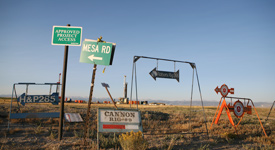 Signs put in all directions to drilling sites in Wyoming. (Credit: Abrahm Lustgarten) |
In a subsequent meeting, an EPA official’s handwritten notes show that a Halliburton attorney asked federal officials, "Are we willing to entertain regulatory relief in other areas; eg: fewer inspections?"
"Willing…," was the reply from Tracy Mehan, then the EPA’s assistant administrator for water.
A Halliburton spokesperson declined to comment on this exchange.
The diesel agreement (PDF) was signed. But according to the EPA, it isn't legally enforceable and the agency hasn't checked to see if diesel is still being used. Furthermore, the agreement applies only to fluids used in a specific kind of gas drilling, not all drilling across the United States.
Mehan did not return calls for comment about his negotiations. Roy Simon, associate chief of the Drinking Water Protection Division's Prevention Branch at EPA headquarters in Washington says the "EPA still stands by the findings outlined in the (2004) report."
But one of the report’s three main authors, Jeffrey Jollie, an EPA hydrogeologist, now cautions that the research has been misconstrued by industry. The study focused solely on the effect hydraulic fracturing has on drinking water in coal bed methane deposits, typically shallow formations where gas is embedded in coal. It didn’t consider the impact of above-ground drilling or of drilling in geologic formations deep underground, where many of the large new gas reserves are being developed today.
"It was never intended to be a broad, sweeping study," Jollie says. "I don’t think we ever characterized it that way."
Nevertheless, a few months after the report’s release, the sweeping 2005 Energy Policy Act was passed. Almost no attention was paid to the three paragraphs that stripped the federal government of most of its authority to monitor and regulate hydraulic fracturing’s impact on the environment. By default, that responsibility would now fall to the states.
“That pretty much closed the door,” said Greg Oberley, an EPA groundwater specialist working in the western drilling states. “So we absolutely do not look at fracking...under the Safe Drinking Water Act. It’s not done.”
Waste Hazards
On April 30, 2001 a small drilling company now owned by the Canadian gas company Encana fractured a well at the top of Dry Hollow, a burgeoning field in western Colorado that has seen one of the fastest rates of energy development in the nation.
The well sat at the end of a dirt drive among pinion pines and juniper at the crest of a small mesa overlooking the Colorado River. It was also less than 1,000 feet from the log farmhouse where Larry and Laura Amos lived.
As usual that day, water trucks lined up like toy soldiers on the three acre dirt pad cleared for drilling just across the Amos’ property line. They pumped 82,000 gallons of fluids at 3,600 pounds of pressure thousands of feet into the drill hole.
Suddenly the Amos' drinking water well exploded like a Yellowstone geyser, firing its lid into the air and spewing mud and gray fizzing water high into the sky. State inspectors tested the Amos well for methane and found lots of it. They did not find benzene or gasoline derivatives and they did not test fracking fluids, state records show, because they didn't know what to test for.
The Amoses were told that methane occurs naturally and is harmless. Inspectors warned them to keep the windows open and vent the basement, but they were never advised to protect themselves or their infant daughter from the water. It wasn't until three years later, when Laura Amos was diagnosed with a rare adrenal tumor, that she started challenging the state about the mysterious chemicals that might have been in her well.
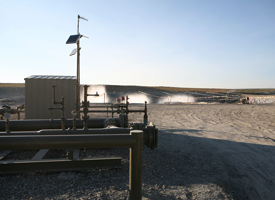 Misted waste fluid rises from waste pits at a Wyoming well site. (Credit: Abrahm Lustgarten/ProPublica) |
Spurred by reports of water contamination in Colorado, Colborn painstakingly gathered the names of chemicals from shipping manifests that trucks must carry when they haul hazardous materials for oil and gas servicing companies. Whenever an accident occurred -- a well spill in Colorado, or an explosion at a drilling site in Wyoming – she took water and soil samples and tested them for contaminants, adding the results to her list.
Industry officials say they use such tiny amounts of chemicals in the drilling – of the million or so gallons of liquid pumped into a well, only a fraction of one percent are chemicals – that they are diluted beyond harmful levels. But on some fracturing sites that tiny percentage translates to more than 10,000 gallons of chemicals, and Colborn believes even very low doses of some of the compounds can damage kidney and immune systems and affect reproductive development.
In Garfield County, there were signs this was already happening. Animals that had produced offspring like clockwork each spring stopped delivering healthy calves, according to Liz Chandler, a veterinarian in Rifle, Co. A bull went sterile, and a herd of beef cows stopped going into heat, as did pigs. In the most striking case, sheep bred on an organic dairy farm had a rash of inexplicable still births -- all in close proximity to drilling waste pits, where wastewater that includes fracturing fluids is misted into the air for evaporation.
Among Colborn’s list of nearly 300 chemicals -- some known to be cancer-causing -- is a clear, odorless surfactant called 2-BE, used in foaming agents to lubricate the flow of fracking fluids down in the well. Colborn told Congress in 2007 that it can cause adrenal tumors.
Laura Amos, who suffered from such a tumor, pressed Encana on whether the compound had been used to fracture the well near her house. For months the company denied 2-BE had been used. But Amos persisted, arguing her case on TV and radio. In January 2005, her lawyers obtained documents from Encana showing that 2-BE had, in fact, been used in at least one adjacent well.
"Our daughter was only six months old when fracturing blew up our water well," Amos wrote in a letter to the Oil and Gas Accountability Project, an anti-drilling group. "I bathed her in that water every day. I also continued breast-feeding her for 18 more months...If there was a chemical in my body causing my tumor, she was exposed to it as well."
In 2006, Amos stopped talking to the media after she accepted a reported multi-million settlement from Encana. The company was fined $266,000 for "failure to protect water-bearing formations and…to contain a release of (gas production) waste." Yet investigators also concluded, without further explanation, that hydraulic fracturing was not to blame.
Asked about the Amos case and the rash of complaints in the area, an Encana spokesman said the company disagreed with the state's judgment on the Amos case and emphasized that there was no proof that fracturing had caused the explosion. Environmentalists had created a climate of fear in the community, he added.
"The concerns residents have expressed -- and some of them are legitimate and heartfelt concerns -- a lot of them are out of misinformation," said Doug Hock. "Just because chemicals are used at a site does not create risk. We have a proven process that helps us ensure that there are no pathways."
'The Tipping Point'
In the past 12 months a flurry of documented incidents has made such reports harder to dismiss.
"We've kind of reached the tipping point," says Dhieux, the EPA inspector in Denver. "The impacts are there."
In December 2007, a house in Bainbridge, Ohio exploded in a fiery ball. Investigators discovered that the neighborhood’s tap water contained so much methane that the house ignited. A study released this month concluded that pressure caused by hydraulic fracturing pushed the gas, which is found naturally thousands of feet below, through a system of cracks into the groundwater aquifer.
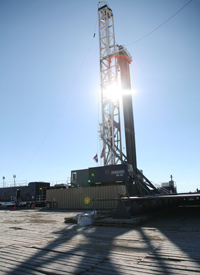 The raised platform used by Encana at some of its drill sites helps to protect the underlying landscape. (Credit: Abrahm Lustgarten/ProPublica) |
As more contamination cases are documented, state governments and Washington are being pressured to toughen oversight. One aim is to institutionalize the precautionary measures some companies are already experimenting with.
When ProPublica visited an Encana drilling operation in Pinedale, for example, the company was placing its drill rigs on raised platforms to protect the underlying landscape and using rubber pools to catch spilled fluids before they could seep into the soil. Drilling companies in New Mexico have begun storing waste in enclosed steel tanks rather than open pits.
Such efforts can add 10 percent to drilling costs, but they also dramatically lessen the environmental risks, an Encana employee said.
State regulators and Washington lawmakers though are increasingly impatient with voluntary measures and are seeking to toughen their oversight. In September, U.S. Congresswoman Diana DeGette and Congressman John Salazar, from Colorado, and Congressman Maurice Hinchey, from New York, introduced a bill that would undo the exemptions in the 2005 Energy Policy Act. Wyoming, widely known for supporting energy development, has begun updating its regulations at a local level, as have parts of Texas.
New Mexico has placed a one-year moratorium on drilling around Santa Fe, after a survey found hundreds of cases of water contamination from unlined pits where fracking fluids and other drilling wastes are stored. "Every rule that we have improved...industry has taken us to court on," said Joanna Prukop, New Mexico’s cabinet secretary for Energy Minerals and Natural Resources. "It’s industry that is fighting us on every front as we try to improve our government enforcement, protection, and compliance…We wear Kevlar these days.”
The most stringent reforms are being pursued in Colorado. Last year it began a top-to-bottom re-write of its regulations, including a proposal to require companies to disclose the exact makeup of their fracking fluids -- the toughest such rule in the nation.
 Cathy Behr (Credit: Abrahm Lustgarten/ProPublica) |
Her doctors searched for details that could save their patient. The substance was a drill stimulation fluid called ZetaFlow, but the only information the rig workers provided was a vague Material Safety Data Sheet, a form required by OSHA. Doctors wanted to know precisely what chemicals make up ZetaFlow and in what concentration. But the MSDS listed that information as proprietary. Behr’s doctor learned, weeks later, after Behr had begun to recuperate, what ZetaFlow was made of, but he was sworn to secrecy by the chemical’s manufacturer and couldn’t even share the information with his patient.
News of Behr’s case spread to New York and Pennsylvania, amplifying the cry for disclosure of drilling fluids. The energy industry braced for a fight.
"A disclosure to members of the public of detailed information…would result in an unconstitutional taking of [Halliburton’s] property," the company told Colorado’s Oil and Gas Conservation Commission. "A number of studies have concluded there are no confirmed incidents of contamination of drinking water aquifers due to stimulation operations…EPA reached precisely this conclusion after undertaking an extensive study."
Then Halliburton fired a major salvo: If lawmakers forced the company to disclose its recipes, the letter stated, it "will have little choice but to pull its proprietary products out of Colorado." The company’s attorneys warned that if the three big fracking companies left, they would take some $29 billion in future gas-related tax and royalty revenue with them over the next decade.
In August, the industry struck a compromise by agreeing to reveal the chemicals in fracturing fluids to health officials and regulators -- but the agreement applies only to chemicals stored in 50 gallon drums or larger. As a practical matter, drilling workers in Colorado and Wyoming said in interviews that the fluids are often kept in smaller quantities. That means at least some of the ingredients won’t be disclosed.
"They’ll never get it," says Bruce Baizel, a Colorado attorney with the Oil and Gas Accountability Project, about the states’ quest for information. "Not unless they are willing to go through a lawsuit. When push comes to shove, Halliburton is there with its attorneys."
Asked for comment, Halliburton would only say that its business depended on protecting such information. Schlumberger and BJ Services, the two other largest fracturing companies, did not return calls for comment.
Lee Fuller, vice-president for government relations at The Independent Petroleum Association of America, said the oil and gas industry’s reluctance to release information about drilling chemicals is to be expected. "These operations are ones where companies have spent millions of dollars," he says. "They are not going to want to give up that competitive advantage. So I would fully expect that they will try to protect that right as long as they possibly can."
Allison Battey, Kristin Jones and Jonathan Sidhu contributed to this report.
A version of this story first appeared on Business Week's Web site and is included in the magazine's print edition.
Investigation: Natural Gas Rush
Fractured Relations -- New York City Sees Drilling as Threat to Its Water Supply
by Abrahm Lustgarten - Aug. 6, 2008 8:30 am
Despite New York's Order for Environmental Review, Gas Drilling May Proceed
by Abrahm Lustgarten - July 24, 2008 11:02 am
Governor Signs Drilling Bill But Orders Environmental Update
by Abrahm Lustgarten - July 23, 2008 5:57 pm
New York's Gas Rush Poses Environmental Threat
by Abrahm Lustgarten - July 22, 2008 2:42 pm
Graphics

Graphic: What is Hydraulic Fracturing?
Other Gas Drilling Coverage
"A Toxic Spew? Officials Worry About Impact of 'Fracking' of Oil and Gas"
by Jim Moscou, Newsweek, Aug. 20, 2008
"Natural Gas Could Transform Sullivan County"
by Ilya Marritz, WNYC, April 9, 2008
Chemical Used in Natural Gas Development and Delivery, The Endocrine Disruption Exchange
Document Dive
Halliburton Celebrates 50-Year Anniversary of Process That 'Energized' Oil and Gas Industry (PDF)
Halliburton's Web site, June 21, 1999
Elimination of Diesel Fuel in Hydraulic Fracturing Fluids Injected into Underground Sources of Drinking Water During Hydraulic Fracturing of Coalbed Methane Wells (PDF),
A Memorandum of Agreement Between the United States Environmental Protection Agency and BJ Services Company, Halliburton Energy Services, Inc., and Schlumberger Technology Corporation, Dec. 12, 2003
A White Paper Describing Produced Water from Production of Crude Oil, Natural Gas, and Coal Bed Methane (PDF),
prepared by the Argonne National Laboratory, January 2004
Evaluation of Impacts to Underground Sources of Drinking Water by Hydraulic Fracturing of Coalbed Methane Reservoirs (PDF),
Environmental Protection Agency, June 2004
New Mexico Gas Pit Sampling Results (PDF),
May 23, 2007
Written Testimony by Theo Colburn, Ph.D. (PDF),
before the House Committee on Oversight and Government Reform, Oct. 25, 2007
Report on the Investigation of the Natural Gas Invasion of Aquifers in Bainbridge Township of Geauga County, Ohio (PDF),
Ohio Department of Natural Resources, Division of Mineral Resources Management, Sept. 1, 2008
© Copyright 2008 Pro Publica Inc. The original content on this site is licensed under
a Creative Commons Attribution-Noncommercial-No Derivative Works 3.0 United States License.